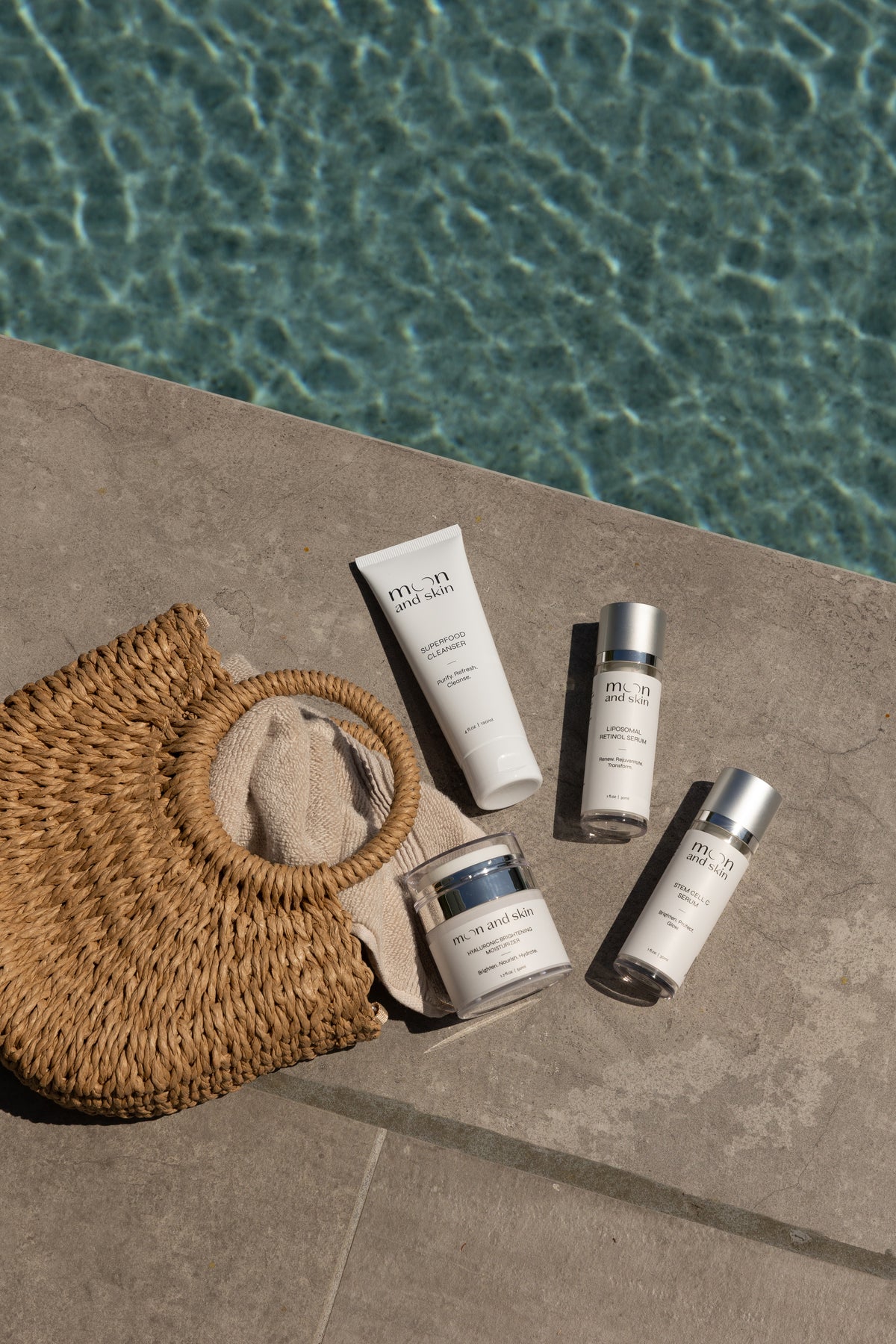विषयोपरि
- परिचय
- जोजोबा तेल को समझना
- अर्जुन तेल की खोज
- जोजोबा तेल बनाम अर्जुन तेल: एक समानांतर तुलना
- संभावित साइड इफेक्ट्स
- निष्कर्ष
- अक्सर पूछे जाने वाले प्रश्न
परिचय
कल्पना कीजिए कि आप स्किनकेयर के चौराहे पर खड़े हैं, दो शक्तिशाली तेलों का सामना कर रहे हैं: जोजोबा और अर्जुन। दोनों ने अपने अनोखे लाभ और सौंदर्य की दिनचर्या में बहुगुणितता के लिए ध्यान आकर्षित किया है। लेकिन आप कैसे तय करेंगे कि कौन सा आपके लिए सही है? बढ़ती संख्या में स्किनकेयर उत्साही लोग प्राकृतिक तेलों की ओर बढ़ रहे हैं, जोजोबा तेल और अर्जुन तेल की बारीकियों को समझना आपकी स्किनकेयर दिनचर्या पर महत्वपूर्ण प्रभाव डाल सकता है।
जोजोबा तेल, अक्सर त्वचा की प्राकृतिक सीबम की समानता के लिए सराहा जाने वाला, उन लोगों के बीच एक प्रमुख बन गया है जो भारीपन के बिना हाइड्रेशन की तलाश में हैं। वहीं, अर्जुन तेल, इसके समृद्ध बनावट और बालों और त्वचा के लिए कथित लाभ के साथ, एक बहुपरकारी चमत्कार तेल के रूप में लोकप्रियता प्राप्त कर रहा है। लेकिन तेलों की दुनिया भारी हो सकती है, और "जोजोबा तेल बनाम अर्जुन तेल" का सवाल एक गहरा अन्वेषण करने योग्य है।
इस ब्लॉग पोस्ट में, हम जोजोबा और अर्जुन तेल दोनों की विशेषताओं, लाभों और आदर्श उपयोगों पर गहराई से चर्चा करेंगे। इस यात्रा के अंत में, आपके पास यह स्पष्ट समझ होगी कि प्रत्येक तेल आपकी स्किनकेयर दिनचर्या में कैसे फिट हो सकता है, जिससे आपको अपनी त्वचा के स्वास्थ्य के बारे में जागरूक निर्णय लेने का अधिकार मिलेगा।
हम दोनों तेलों के निकासी प्रक्रियाओं, उनकी रासायनिक संरचनाओं, वे विभिन्न त्वचा प्रकारों के साथ कैसे इंटरैक्ट करते हैं, उनके संभावित लाभ, संभावित साइड इफेक्ट्स और व्यावहारिक अनुप्रयोगों को कवर करेंगे। चलिए इस उज्ज्वल अन्वेषण पर एक साथ चलते हैं!
जोजोबा तेल को समझना
जोजोबा तेल क्या है?
जोजोबा तेल जोजोबा पौधे (Simmondsia chinensis) के बीजों से निकाला जाता है, जो कि दक्षिण-पश्चिमी संयुक्त राज्य अमेरिका और उत्तरी मेक्सिको का स्वदेशी है। यह तेल कैरियर तेलों में अद्वितीय है क्योंकि यह तकनीकी रूप से एक मोम एस्ट्र है, ना कि ट्राइग्लिसराइड। यह विशिष्टता जोजोबा तेल को हमारे द्वारा उत्पादित प्राकृतिक तेलों की अनुकरण करने की अनुमति देती है, जिससे यह एक अद्भुत हाइड्रेटर और मॉइस्चराइज़र बनता है।
निकासी प्रक्रिया
जोजोबा तेल की निकासी में जोजोबा पौधे के बीजों को ठंडा दबाने की प्रक्रिया शामिल होती है। यह विधि तेल की लाभकारी गुणों को संरक्षित करती है, यह सुनिश्चित करती है कि यह अपनी प्राकृतिक सुगंध और रंग को बनाए रखता है। नतीजा एक सुनहरा, थोड़ा नट किस्म का तेल है जो स्थिर है और इसकी लंबी शेल्फ लाइफ है, जिससे यह स्किनकेयर सूत्रीकरण के लिए एक लोकप्रिय विकल्प बनता है।
रासायनिक संरचना
जोजोबा तेल मुख्य रूप से लंबे-श्रृंखला फैटी एसिड और फैटी अल्कोहल का संयोजन है, जो इसे उच्च स्तर का मॉइस्चराइजिंग बनाता है। खासकर, इसमें मायरीस्टिक एसिड, पैल्मिटोलेइक एसिड, और ओलेइक एसिड शामिल हैं, जो इसके मॉइस्चराइजिंग गुणों में योगदान करती हैं। इसके अलावा, जोजोबा तेल विटामिन ई और बी में समृद्ध है, साथ ही जस्ता और तांबा जैसे खनिज भी होते हैं, जो त्वचा के स्वास्थ्य में महत्वपूर्ण भूमिका निभाते हैं।
जोजोबा तेल के लाभ
-
मॉइस्चराइजिंग: जोजोबा तेल एक उत्कृष्ट मॉइस्चराइज़र है, क्योंकि यह बिना छिद्रों को बंद किए त्वचा में गहराई तक प्रवेश करता है। यह इसे सभी त्वचा प्रकारों, विशेष रूप से तैलीय और मुँहासे-प्रवण त्वचा के लिए उपयुक्त बनाता है।
-
संतुलन बनाने वाला: क्योंकि यह त्वचा के प्राकृतिक तेलों की अनुकरण करता है, जोजोबा तेल सीबम उत्पादन को नियंत्रित करने में मदद कर सकता है। यह तैलीय या संयोजक त्वचा वाले लोगों के लिए विशेष रूप से लाभकारी है।
-
सुखदायक: जोजोबा तेल में सूजन रोधी गुण होते हैं जो उत्तेजित त्वचा को शांत कर सकते हैं और लाली को कम कर सकते हैं, इसे संवेदनशील त्वचा वाले प्रकारों के लिए आदर्श बनाते हैं।
-
एंटीऑक्सीडेंट सुरक्षा: जोजोबा तेल में विटामिन ई की उपस्थिति एंटीऑक्सीडेंट सुरक्षा प्रदान करती है, जो मुक्त कणों से लड़ने में मदद करती है जो त्वचा के उम्र बढ़ने में योगदान कर सकते हैं।
-
गैस्ट्रिक: जोजोबा तेल गैस्ट्रिक नहीं है, जिसका अर्थ यह है कि यह छिद्रों को बंद नहीं करेगा और मुँहासे की समस्याएं उत्पन्न नहीं करेगा, जिससे यह मुँहासे-प्रवण व्यक्तियों के लिए एक सुरक्षित विकल्प बनता है।
आदर्श उपयोग
जोजोबा तेल का विभिन्न तरीकों से उपयोग किया जा सकता है, जैसे:
- चेहरे और शरीर के लिए दैनिक मॉइस्चराइजिंग के रूप में।
- आवश्यक तेलों को पतला करने के लिए एक कैरियर तेल के रूप में।
- बालों की देखभाल में, सूखे बालों और स्कैल्प को चमक और नमी देने के लिए।
- मेकअप रिमूवर के रूप में, त्वचा में बिना उत्तेजना के मेकअप को प्रभावी तरीके से तोड़ने के लिए।
अर्जुन तेल की खोज
अर्जुन तेल क्या है?
अर्जुन तेल अर्जुन तेल पौधे (Ricinus communis) के बीजों से निकाला जाता है। इस तेल का उपयोग सदियों से इसके विविध अनुप्रयोगों के लिए किया गया है, पारंपरिक चिकित्सा से लेकर कॉस्मेटिक सूत्रों तक। जोजोबा तेल के विपरीत, अर्जुन तेल अपनी मोटी स्थिरता और हल्की चिपचिपी बनावट के लिए जाना जाता है।
निकासी प्रक्रिया
अर्जुन तेल को अर्जुन तेल पौधे के बीजों को ठंडा दबाने द्वारा प्राप्त किया जाता है। बीजों में एक विषैले पदार्थ होता है जिसे राइसिन कहा जाता है, जो तेल निकासी प्रक्रिया के दौरान हटा दिया जाता है, जिससे सुरक्षित और लाभकारी तेल बनता है।
रासायनिक संरचना
अर्जुन तेल का प्राथमिक घटक राइसिनोलेइक एसिड है, एक फैटी एसिड जो इसके 90% संरचना का निर्माण करता है। यह अद्वितीय फैटी एसिड कई तेल के त्वचा लाभों के लिए जिम्मेदार माना जाता है। इसके अतिरिक्त, अर्जुन तेल में ओलेइक और लिनोलेइक एसिड जैसे अन्य फैटी एसिड भी होते हैं, जो इसके मॉइस्चराइजिंग गुणों में योगदान करते हैं।
अर्जुन तेल के लाभ
-
गहरा मॉइस्चराइजेशन: अर्जुन तेल की मोटी स्थिरता इसे त्वचा पर एक बाधा बनाने की अनुमति देती है, जिससे नमी को लॉक किया जाता है और निर्जलीकरण को रोकता है, जिससे यह सूखी त्वचा के लिए एक उत्कृष्ट विकल्प बनता है।
-
चिकित्सा गुण: राइसिनोलेइक एसिड के सूजन रोधी गुण उत्तेजित त्वचा को शांत करने और छोटे कट और घावों के उपचार में मदद कर सकते हैं।
-
बाल विकास: अर्जुन तेल बाल विकास को बढ़ावा देने के लिए अपनी संभावित लाभों के लिए व्यापक रूप से जाना जाता है। यह स्कैल्प में रक्त संचार को उत्तेजित करने की क्षमता रखता है, जो स्वस्थ बाल कणों को प्रोत्साहित कर सकता है।
-
एंटीबैक्टीरियल गुण: अर्जुन तेल में प्राकृतिक एंटीबैक्टीरियल गुण होते हैं, जो छोटे घावों पर लगाकर संक्रमण के जोखिम को कम करने में मदद कर सकते हैं।
-
उपयोग में लचीलापन: इसकी मोटी बनावट के कारण, अर्जुन तेल को हल्के तेलों के साथ मिश्रित किया जा सकता है, जिससे यह विभिन्न सूत्रों के लिए बहुउद्देशीय बनता है।
आदर्श उपयोग
अर्जुन तेल का कई तरीकों से उपयोग किया जा सकता है, जैसे:
- अतिसूखी त्वचा के क्षेत्रों, जैसे कोहनियों और एड़ियों के लिए एक मॉइस्चराइज़र के रूप में।
- बालों की देखभाल की दिनचर्या में, विकास और चमक को बढ़ावा देने के लिए एक उपचार के रूप में।
- DIY स्किनकेयर और बालों की देखभाल उत्पादों में मोटाई बढ़ाने वाला एजेंट के रूप में।
- चश्मा और भौहों के सुधार के लिए, हालांकि उत्तेजना से बचने के लिए सावधानी बरती जानी चाहिए।
जोजोबा तेल बनाम अर्जुन तेल: एक समानांतर तुलना
संरचना और अवशोषण
- जोजोबा तेल: हल्का और त्वचा में आसानी से अवशोषित होता है, जिससे यह दैनिक उपयोग के लिए उपयुक्त होता है बिना चिकने अवशेष छोड़े।
- अर्जुन तेल: मोटा और चिपचिपा; इसे अवशोषित होने में अधिक समय लगता है और यह हल्का तेलीय फिल्म छोड़ सकता है, जिससे यह लक्षित अनुप्रयोगों के लिए अधिक उपयुक्त बनता है।
त्वचा की संगतता
- जोजोबा तेल: सभी त्वचा प्रकारों के लिए उत्कृष्ट, विशेष रूप से तैलीय और मुँहासे-प्रवण के लिए इसकी गैर-कॉमेडोजेनिक प्रकृति के कारण।
- अर्जुन तेल: सूखी त्वचा के प्रकारों के लिए अधिक लाभकारी। यह तैलीय या मुँहासे-प्रवण त्वचा के लिए बहुत भारी हो सकता है, और पूर्ण उपयोग से पहले पैच परीक्षण की सिफारिश की जाती है।
लचीलापन
- जोजोबा तेल: अत्यधिक लचीला; इसे स्किनकेयर, हेयरकेयर में, और आवश्यक तेलों के लिए कैरियर तेल के रूप में इस्तेमाल किया जा सकता है।
- अर्जुन तेल: विशेष अनुप्रयोगों के लिए प्राथमिक रूप से उपयोग किया जाता है, विशेष रूप से बालों की देखभाल और सूखी त्वचा के लिए चिकित्सा उपचार के रूप में।
पोषण के लाभ
- जोजोबा तेल: विटामिन ई और बी में समृद्ध, एंटीऑक्सीडेंट सुरक्षा और हाइड्रेशन प्रदान करता है।
- अर्जुन तेल: राइसिनोलेइक एसिड में उच्च, जो इसके सूजन रोधी और मॉइस्चराइजिंग गुणों में योगदान करता है।
संभावित साइड इफेक्ट्स
हालांकि ये दोनों तेल सामान्यतः त्वचा पर प्रयोग के लिए सुरक्षित हैं, यह संभावित साइड इफेक्ट्स के प्रति सजग रहना आवश्यक है:
- जोजोबा तेल: दुर्भाग्यवश एलर्जीक प्रतिक्रियाएँ कम ही होती हैं, लेकिन नट्स की एलर्जी वाले व्यक्तियों को एक पैच टेस्ट करना चाहिए।
- अर्जुन तेल: कुछ व्यक्तियों में एलर्जीक प्रतिक्रियाएँ हो सकती हैं; विशेष रूप से संवेदनशील त्वचा वाले लोगों के लिए व्यापक उपयोग से पहले पैच टेस्ट करना महत्वपूर्ण है।
निष्कर्ष
"जोजोबा तेल बनाम अर्जुन तेल" बहस में, दोनों तेलों की अपनी अद्वितीय शक्तियाँ और अनुप्रयोग हैं। जोजोबा तेल हल्के, बहुगुणित विकल्प के रूप में चमकता है जो विभिन्न त्वचा प्रकारों के लिए उपयुक्त है, जबकि अर्जुन तेल गहरे हाइड्रेशन और चिकित्सा गुण प्रदान करता है, विशेष रूप से सूखी त्वचा वाले लोगों के लिए लाभकारी।
अंततः, जोजोबा और अर्जुन तेल के बीच का चुनाव आपके व्यक्तिगत त्वचा प्रकार और विशिष्ट आवश्यकताओं पर निर्भर करता है। आप यह भी पा सकते हैं कि अपने स्किनकेयर दिनचर्या में दोनों तेलों को मिलाना सहयोगी लाभ प्रदान कर सकता है, जिससे आप दोनों दुनियाओं के सर्वश्रेष्ठ का लाभ उठा सकते हैं।
जब आप अपने स्किनकेयर यात्रा को नेविगेट करते हैं, तो याद रखें कि शिक्षा की कुंजी है। प्राकृतिक तेलों की सुंदरता को अपनाएं, जबकि यह सावधानी भी बरतें कि यह आपकी त्वचा के साथ कैसे इंटरैक्ट करते हैं। अधिक जानकारी, टिप्स, और विशेष ऑफ़र के लिए, हमारे “ग्लो सूची” में शामिल हों, अपना ईमेल Moon and Skin पर प्रस्तुत करके। हम आपकी चमकदार त्वचा पाने की यात्रा में आपके सहयोग को लेकर उत्सुक हैं!
अक्सर पूछे जाने वाले प्रश्न
1. क्या मैं जोजोबा तेल और अर्जुन तेल को एक साथ उपयोग कर सकता हूँ?
हाँ, जोजोबा तेल और अर्जुन तेल का संयोजन स्किनकेयर के लिए एक संतुलित दृष्टिकोण प्रदान कर सकता है। जोजोबा तेल अर्जुन तेल के भारीपन को हल्का करने में मदद कर सकता है, जिससे एक मिश्रण तैयार होता है जो हाइड्रेट करता है बिना बहुत मोटा होने के।
2. मुँहासे-प्रवण त्वचा के लिए कौन सा तेल बेहतर है?
जोजोबा तेल सामान्यतः मुँहासे-प्रवण त्वचा के लिए बेहतर होता है इसकी गैर-कॉमेडोजेनिक गुणों के कारण। यह छिद्रों को बंद किए बिना तेल उत्पादन को संतुलित करने में मदद करता है।
3. मैं इन तेलों का उपयोग कितनी बार कर सकता हूँ?
जोजोबा तेल को दैनिक रूप से उपयोग किया जा सकता है, जबकि अर्जुन तेल को कुछ बार सप्ताह में या आवश्यकतानुसार, विशेष रूप से उन क्षेत्रों में जहां अतिरिक्त नमी या उपचार की आवश्यकता होती है, में सर्वोत्तम उपयोग किया जाता है।
4. क्या इन तेलों के उपयोग के लिए कोई contraindications हैं?
नट्स की एलर्जी वाले व्यक्तियों को जोजोबा तेल के साथ सतर्क रहना चाहिए, जबकि संवेदनशील त्वचा वाले लोगों को अर्जुन तेल का व्यापक उपयोग करने से पहले पैच टेस्ट करना चाहिए।
5. क्या इन तेलों का उपयोग बालों पर किया जा सकता है?
बिल्कुल! जोजोबा तेल और अर्जुन तेल दोनों बालों के लिए लाभकारी हो सकते हैं। जोजोबा तेल नमी और चमक जोड़ता है, जबकि अर्जुन तेल स्वस्थ बाल वृद्धि को बढ़ावा दे सकता है।







